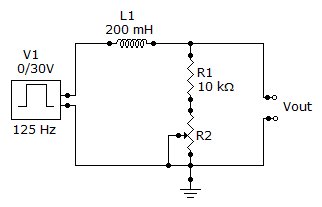Discussion
Home ‣ Electrical Engineering ‣ Time Response of Reactive Circuits Comments
- Question
Referring this circuit, determine the maximum output voltage when a single pulse is applied as shown. The total resistance is 60 Ω.

Options- A. 2.73 V
- B. 27.33 V
- C. 30 V
- D. 2.67 V
- Correct Answer
- 27.33 V
- 1. If the capacitor in an integrator becomes leaky,
Options- A. the time constant will be effectively reduced
- B. the waveshape of the output voltage across C is altered
- C. the amplitude of the output is reduced
- D. all of the above Discuss
- 2. With an RL integrator, at the instant of the rising pulse edge,
Options- A. all the input voltage is across the resistor
- B. all the input voltage is across the inductor
- C. 63 percent of the input voltage is across the resistor
- D. 63 percent of the input voltage is across the inductor Discuss
- 3. Referring to Problem 7, how much will the capacitor charge if the pulse width is increased to 12 ms?
Options- A. 2.51 V
- B. 25.14 V
- C. 4.86 V
- D. 12.76 V Discuss
- 4. What is the highest frequency contained in a pulse that has a rise and fall time equal to 10 microseconds (10 µs)?
Options- A. 35 kHz
- B. 3.5 kHz
- C. 10 kHz
- D. 100 kHz Discuss
- 5. If a periodic pulse waveform has a pulse width and the time between pulses each equal to or greater than five time constants, the capacitor will
Options- A. partially charge and fully discharge during each period of the input waveform
- B. fully charge and partially discharge during each period of the input waveform
- C. fully charge and fully discharge during each period of the input waveform
- D. partially charge and partially discharge during each period of the input waveform Discuss
- 6. If the RC time constant of an integrator is increased, as the time constant is increased
Options- A. the capacitor charges more during a pulse and discharges less between pulses
- B. the capacitor charges less during a pulse and discharges more between pulses
- C. the capacitor charges more during a pulse and discharges more between pulses
- D. the capacitor charges less during a pulse and discharges less between pulses Discuss
- 7. In an RC differentiator, the capacitor
Options- A. charges exponentially at a rate depending on the RC time constant
- B. charges exponentially at a rate depending on the input voltage
- C. charges when the input voltage is decreasing
- D. charges to approximately one time constant Discuss
- 8. In an RC differentiator, the sum of the capacitor voltage and the resistor voltage at any instant
Options- A. must be zero
- B. must be equal to the applied voltage
- C. is less than the applied voltage but greater than zero
- D. cannot be determined Discuss
- 9. A steady-state condition is reached when
Options- A. the output voltage reaches the average value of the input voltage
- B. the output voltage reaches the input voltage
- C. the output voltage reaches approximately 63% of the input voltage
- D. the output voltage reaches the effective value of the input voltage Discuss
- 10. In an RL differentiator, when the input pulse goes from its low level to its high level,
Options- A. the inductor prevents a sudden change in voltage
- B. the inductor prevents a sudden change in current
- C. voltage across the inductor instantly reaches 63% of input voltage
- D. voltage across the inductor is zero Discuss
Time Response of Reactive Circuits problems
Search Results
Correct Answer: all of the above
Correct Answer: all the input voltage is across the inductor
Correct Answer: 25.14 V
Correct Answer: 35 kHz
Correct Answer: fully charge and fully discharge during each period of the input waveform
Correct Answer: the capacitor charges less during a pulse and discharges less between pulses
Correct Answer: charges exponentially at a rate depending on the RC time constant
Correct Answer: must be equal to the applied voltage
Correct Answer: the output voltage reaches the average value of the input voltage
Correct Answer: the inductor prevents a sudden change in current
Comments
There are no comments.More in Electrical Engineering:
Programming
Copyright ©CuriousTab. All rights reserved.
